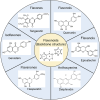Potential of functional flavonoids in targeting vasospasm through modulation of oxidative stress and SPC-induced signaling pathways
- PMID: 40567377
- PMCID: PMC12187668
- DOI: 10.3389/fphar.2025.1594060
Potential of functional flavonoids in targeting vasospasm through modulation of oxidative stress and SPC-induced signaling pathways
Abstract
Vasospasm is a sustained abnormal contraction of vascular smooth muscle (VSM), which is commonly observed in the coronary and cerebral arteries. This abnormal VSM contraction leads to reduced blood flow to tissues or organs, ultimately causing severe diseases such as myocardial infarction and cerebral infarction. Studies have demonstrated that oxidative stress and sphingosylphosphorylcholine (SPC)-induced Rho-kinase signaling pathways are related to this abnormal contraction. Flavonoids, a class of natural compounds, are found in various plants, fruits, vegetables, and traditional Chinese medicines. They have anti-inflammatory, antioxidative, and anticarcinogenic properties. Recent studies have shown that some flavonoids strongly inhibit the abnormal contraction of VSM. This review explores the potential of flavonoids as candidate drugs for the treatment and prevention of vasospasm through oxidative stress and the SPC-induced Rho-kinase signaling pathway. Nevertheless, more extensive studies are required to fully elucidate the mechanism by which flavonoids exert their anti-vasospastic effects and explore their potential benefits as adjunctive therapy for critical cardiovascular and cerebrovascular diseases.
Keywords: ROS; SPC; flavonoids; oxidative stress; vasospasm.
Copyright © 2025 Zhang, Maejima, Matsuzaki and Kishi.
Conflict of interest statement
The authors declare that the research was conducted in the absence of any commercial or financial relationships that could be construed as a potential conflict of interest.
Figures




Similar articles
-
Neuroprotective potential of hispidulin and diosmin: a review of molecular mechanisms.Metab Brain Dis. 2025 Apr 21;40(5):188. doi: 10.1007/s11011-025-01615-9. Metab Brain Dis. 2025. PMID: 40257619 Review.
-
A rapid and systematic review of the clinical effectiveness and cost-effectiveness of paclitaxel, docetaxel, gemcitabine and vinorelbine in non-small-cell lung cancer.Health Technol Assess. 2001;5(32):1-195. doi: 10.3310/hta5320. Health Technol Assess. 2001. PMID: 12065068
-
Systemic pharmacological treatments for chronic plaque psoriasis: a network meta-analysis.Cochrane Database Syst Rev. 2017 Dec 22;12(12):CD011535. doi: 10.1002/14651858.CD011535.pub2. Cochrane Database Syst Rev. 2017. Update in: Cochrane Database Syst Rev. 2020 Jan 9;1:CD011535. doi: 10.1002/14651858.CD011535.pub3. PMID: 29271481 Free PMC article. Updated.
-
Signs and symptoms to determine if a patient presenting in primary care or hospital outpatient settings has COVID-19.Cochrane Database Syst Rev. 2022 May 20;5(5):CD013665. doi: 10.1002/14651858.CD013665.pub3. Cochrane Database Syst Rev. 2022. PMID: 35593186 Free PMC article.
-
Systemic pharmacological treatments for chronic plaque psoriasis: a network meta-analysis.Cochrane Database Syst Rev. 2021 Apr 19;4(4):CD011535. doi: 10.1002/14651858.CD011535.pub4. Cochrane Database Syst Rev. 2021. Update in: Cochrane Database Syst Rev. 2022 May 23;5:CD011535. doi: 10.1002/14651858.CD011535.pub5. PMID: 33871055 Free PMC article. Updated.
References
-
- Alrumaihi F., Almatroodi S. A., Alharbi H. O. A., Alwanian W. M., Alharbi F. A., Almatroudi A., et al. (2024). Pharmacological potential of kaempferol, a flavonoid in the management of pathogenesis via modulation of inflammation and other biological activities. Molecules 29, 2007. 10.3390/molecules29092007 - DOI - PMC - PubMed
Publication types
LinkOut - more resources
Full Text Sources

